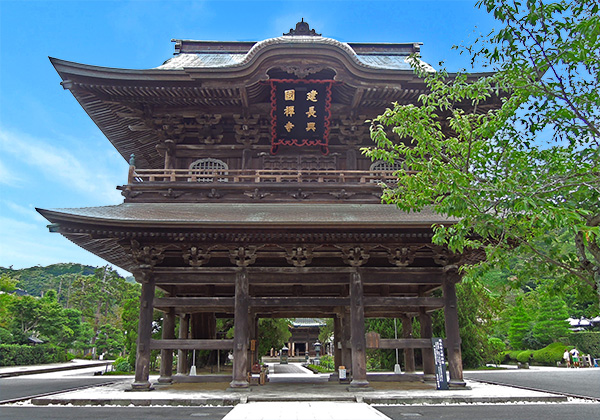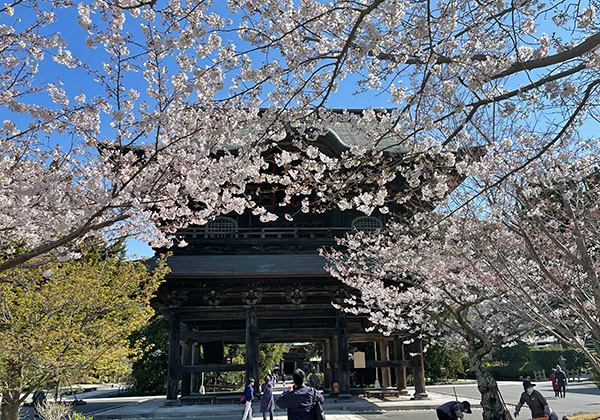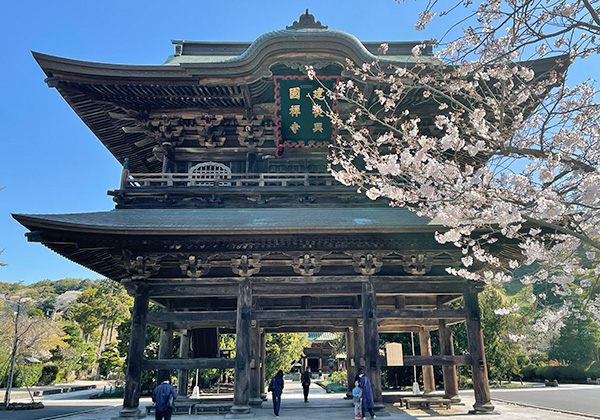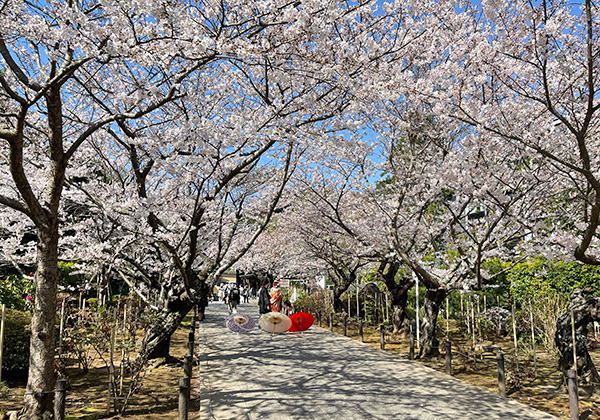Kenchoji
| Official Name | Kofukuzan Kencho Kokoku Zenji {Pronounced koh-foo-koo-zan ken-cho koh-kok-zen-gee} |
|---|---|
| Religious sect | Kenchoji School, Rinzai (Zen) Sect, Buddhism |
| Founded | in 1253 by Tokiyori Hojo {toh-key-yoh-re hoh-joe} |
| Founding priest | Doryu Rankei {doe-ryu ran-kay) (Chinese: Lan-hsi Tao-lung) |
| Main object of worship | Statue of Jizo Bosatsu {gee-zoe bo-sah-tsu} |
| Address | 8, Yamanouchi, Kamakura, Kanagawa 247-0062 (show route from current location ) |
| Location | 1,100 meters southeast of Kita-Kamakura Station |
| Time needed to get there | 17 minutes from the Station |
| Admission | JPY500 |
| Open | 8:30 - 16:30 |
| Phone number | 0467-22-0981 |
| Restrooms | Available |
Historical Overview
Kenchoji was the first zen temple erected in Kamakura and the pioneer of Zen Buddhism in Japan. It ranks first among the Five Great Zen-Temples in Kamakura and is the head of the 500-odd branch temples belonging to the Kenchoji school of the Rinzai Zen sect. It used to have seven main buildings and 49 sub-temples in its golden days. Records show that at the memorial service for Sadatoki Hojo {sah-dah-toh-key hoh-joe} (1271-1311), the Ninth Hojo Regent, held in 1323 at Engakuji for his twelfth anniversary of death, 388 priests joined it from Kenchoji, and further narrate that more than 1,000 people were living in this compound back then. As were the cases in other temples, however, all of original buildings were destroyed by a series of disasters such as fires, earthquakes and civil wars. To be specific, the earthquakein 1293, the fires in 1315, 1414, 1426 etc. ravaged most of the structures and the present ones were either rebuilt recently or brought from outside Kamakura.
Tokiyori Hojo (1227-1263), the Fifth Hojo Regent and the founder of the Temple, was an ardent devotee of Zen. Since there was no Zen master in Japan, he looked for an excellent Zen priest in China. Hearing Zen was getting popular in Japan, Priest Doryu Rankei (1213-1278), a Chinese Zen master under the Sung Dynasty born in Zhejiang Province near Shanghai, left China in 1246 at age 33 to teach Zen in Japan. He first stayed in Kyushu and then went to Kyoto before coming to Kamakura. In Kamakura, he started serving in Jufukuji at first, and then was invited to Kenchoji by Tokiyori Hojo to officiate as the founding priest. In 1262, he moved to Ken-ninji in Kyoto, which also belonged to the Rinzai sect and ranked third of the Five Great Zen Temples in Kyoto.
The post of the second chief priest of Kenchoji was succeeded by Funei Gottan {foo-ney got'an} (1197-1276), another Chinese Zen priest and fellow priest of Rankei. Back at the time, China was invaded by Mongol and the Mongolian rulers clamped down on Buddhism. Rather than staying in China, he challenged to expatriate himself to Japan and propagate Zen. When he first faced the main object of the Temple, he was quoted as having said, "Since Jizo Bosatsu ranks below me, it is he who should kneel to me". With the support of Tokiyori Hojo, he was happy in Kamakura, but suddenly returned to China upon the death of Tokiyori.
Priest Rankei came back to Kenchoji as the third chief priest. Unlike Priest Gottan, he learned the Japanese language quickly and was later naturalized as a Japanese citizen. He spoke Japanese so fluently that he was suspected as a Mongolian spy in 1271 when Mongolian envoys visited Japan, and was sent to a remote town near Mt. Fuji twice. The suspicion was later dispelled and the honorable title of Daigaku Zen-ji {dye-gak zen-gee} (Zen Master of Great Realization. "Ji" means a teacher, not a temple in this case) was conferred as his posthumous title, the first priest ever receiving such a Buddhist name. He is also known as a good disciplinarian and trained his disciples with asceticism. The Temple keeps an old document entitled Codes of Conduct for Zen Priests written by him, which is, by the way, a National Treasure. His tombstone called "Daigaku Zen-ji Tower", stands at the rear of the right-hand hill in the Temple's grounds.
Eighth Hojo Regent Tokimune {toh-key-moo-neh} Hojo (1251-1284), son of Tokiyori, invited Sogen Mugaku {soh-ghen moo-gah-koo} (1226-1286), another Chinese priest, in 1279 from China as the Priest Rankei's successor. Priest Mugaku was nominated as the founding priest of Engakuji, but also served as the chief priest of Kenchoji.
After the Kamakura Period (1185-1333), the Temple continued to receive support from the governments of the time. For example, the Five Great Zen Temple system was initiated by Yoshimitsu Ashikaga {yo-she-me-tsu ah-she-kah-gah} (1358-1408), the Third Shogun of the Muromachi Period (1336-1573) when he was in power, and Kenchoji was ranked as the first of them. However, it did not flourish as it had been before. Fires and earthquakes gave dire damages, destroying all of existing structures. In particular, the fire in 1414 wrought the worst damage ever and the Temple lost almost all of its assets. In 1591, Ieyasu Tokugawa {e-eh-yah-soo toh-koo-gah-wah} (1542-1616), the founder of the Tokugawa Shogunate, began to give financial aid to Kenchoji and it was able to revive to a certain extent, and some of the present structures were brought here from Tokyo by the help of the Tokugawa Shogunate. In the late Edo Period (1603-1868), the Tokugawa Shogunate introduced a parishioner system called danka {dan-kah} in an attempt to oppress Christians. It required every person to register at a temple and the temple took care of funeral and other religious services for all those parishioners, who in return made monetary offerings to the temple.
Thus, temples were financially able to get by until the Meiji Imperial Restoration of 1868. It was another tuning point for the temples. With the newly established imperial government designating the Shinto as the state religion, Buddhist temples throughout Japan began to decline. Kamakura replete with old temples went downhill from year to year and was turned to a deserted village in the end. A photo taken at Wakamiya Oji (the main street of Kamakura) in the early Meiji Period (1868-1912) shows the area is mostly covered with rice paddies and a few thatched-roof poor farmhouses. However, opening of the railway in 1889 connecting Tokyo with Kamakura gave a big opportunity for the temples as well as village of Kamakura to revive. Today, as one of the oldest and largest Zen temples, Kenchoji attracts over a million visitors a year and the parking lot near the entrance is often occupied by cars and sightseeing buses.






